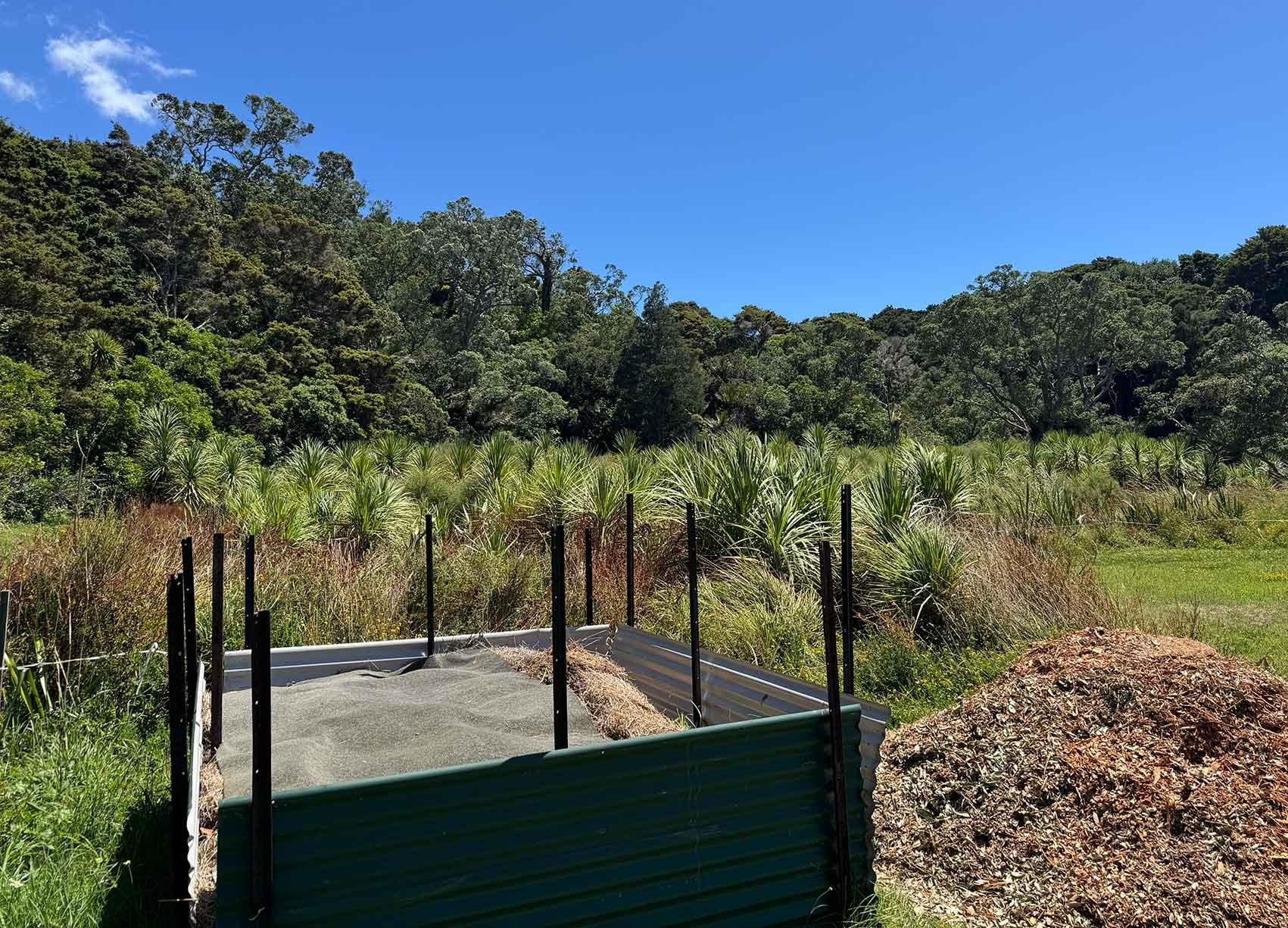How to Compost Kina
(part one)
Words by Kate McConnell.
The composting site at Matheson Bay.
Photos by Benthics.
A dedicated group of project volunteers designed a composting process to honour the kina that were harvested through our kelp restoration program, by returning their shells to Te Kohuroa’s ecosystem through the wetland replanting programme.
Making beautiful compost isn’t rocket science. You take some carbon and some nitrogen, mix together in fine layers, in a big enough pile (1 cubic metre), and keeping it just moist enough you can watch it break down over a few months into a beautiful rich loam. You can add beneficial extras like gardener’s lime and essential microorganisms (think probiotics for soil like our gut probiotics). Carbon usually comes in the colour brown – anything dead like fallen leaves, twigs, brown cardboard and wood chips. Nitrogen includes green weeds, grass clippings, animal manure, vegetable scraps.
The thing about making good compost is to ensure that your ingredients are in smallish particles and your layers are fine. A thick branch takes a long time to break down compared to a wood chip. So also the kina shells needed to be broken down.
“ Kina are a taonga (treasure) species, so our kelp restoration design has been guided by holistic approaches that respect the mauri of the moana.”
- Te Kohuroa Rewilding.
Working with Kina shells
I started my research on kina composting by contacting my favourite permaculture person Trish Allen. She knew of someone who had composted kina for their market gardening business many years ago. Trish surmised that the kina exoskeleton is full of calcium carbonate so we wouldn’t need any extra lime. Somewhere on google I read something about soaking the kina in fresh water to soften and dislodge the spines. And so, our kina composting test experiment began.
Refining the Process
Before the community harvest days, we harvested a small amount of kina from the restoration site and divided them into two trials; one using harvested kina straight from the sea, and the other using freshly harvested kina soaked in rain water for an hour.
Our three objectives were:
kill the kina as quickly and as humanely as possible
enable the quickest breakdown of the test (kina shell) and spines
mitigate any smell coming from decomposing roe
Cheri Crosby (a fellow project volunteer) and I trialled two crushing techniques to breakdown the shells both involved cutting the kina in half with a spade to kill quickly; then one lot of shells were chopped up in a bucket (about 1/3rd full) with a spade and another lot was put into a rusty old concrete mixer with some rocks, manually turning and churning them. Both techniques took at least 10-15 mins to get a decent breakdown of the unsoaked kina shells, but Cheri’s ‘spade in bucket’ approach proved more practical and effective. Cheri’s method was always going to be a winner, the concrete mixer was just cute.
Crushed shells (above), compost after two weeks (below).
Photos: Kate McConnell.
A breakthrough.
Now to the soaked kina shells. Honestly, I turned my back for a minute to harvest some weeds for the compost and there was a yelp from Cheri. The soaked shells had turned to mush under her wieldy spade in less than a minute! This was exciting.
So after an hour of soaking, the kina shells would break down in a few seconds with the bucket and spade method, compared to 10-15mins of continual spade action to chop up the unsoaked kina. This was the perfect method. They were killed as quickly as possible, then the soaking had a dramatic effect on the exoskeleton, softening the shell and dislodging the spines.
Whilst we were doing all of this, we also noticed there was no smell, which was really helpful as the main site would be at the public reserve.
Making the first batch
The compost was layered just like a lasagna: wood chips about 20 cm thick, then kina shell mix poured over, with EM (essential microorganisms) & molasses 10ml of each mixed in 10L water, then horse manure. All of this was repeated a few times to create the layers.
A couple of weeks later I ventured beneath the surface to see what was happening in our little haven of decomposition. The difference between the two processes was incomparable! The soaked kina were almost invisible after two weeks in the compost, just lots of lovely little white bugs where the kina would have been, whereas the unsoaked kina were still visible as small dry segments of shell and spines with far less organism action. And once again, no smell! Just that lovely sweet earthy quality.
Leigh School students participating in the Wetland planting programme earlier in 2024.
Finally, we found our process and were ready to scale up at the Te Kohuroa Reserve for the planting programme!
Want to know how the composting process went on our community restorations days?
Stay tuned for Part Two of the process, where the volunteer team will share their experiences and the events on the day.
About the Author
Kate McConnell is an loam lover, holistic gardener, medical herbalist and enthusiast of marine algae. She lives close to Nordic Bay - her local swimming and snorkelling sanctuary - where she participates in the monitoring of local seabirds. Kate has been an integral and valued member of Te Kohuroa Rewilding ‘s Steering Group since the project’s inception in 2022.




